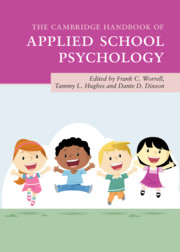Book contents
- The Cambridge Handbook of Applied School Psychology
- The Cambridge Handbook of Applied School Psychology
- Copyright page
- Contents
- Contributors
- Contributor Biographies
- Acknowledgments
- 1 Broadening the Focus of School Psychology Practice
- Part I Individual-Level Academic Interventions
- Part II Teacher- and System-Level Interventions
- Part III Interventions from Educational and Social/Personality Psychology
- Part IV Behavioral and Social-Emotional Interventions
- Part V Health and Pediatric Interventions
- 26 Impairments Related to Medical Conditions
- 27 Psychological Considerations for Asthma
- 28 Substance Use and Misuse Prevention: Guidance for Practitioners
- 29 Coordinating Services with Nonschool Providers
- Part VI Family Connections and Life Transitions
- Part VII Special Populations
- Part VIII Conclusion
- Index
- References
26 - Impairments Related to Medical Conditions
from Part V - Health and Pediatric Interventions
Published online by Cambridge University Press: 18 September 2020
- The Cambridge Handbook of Applied School Psychology
- The Cambridge Handbook of Applied School Psychology
- Copyright page
- Contents
- Contributors
- Contributor Biographies
- Acknowledgments
- 1 Broadening the Focus of School Psychology Practice
- Part I Individual-Level Academic Interventions
- Part II Teacher- and System-Level Interventions
- Part III Interventions from Educational and Social/Personality Psychology
- Part IV Behavioral and Social-Emotional Interventions
- Part V Health and Pediatric Interventions
- 26 Impairments Related to Medical Conditions
- 27 Psychological Considerations for Asthma
- 28 Substance Use and Misuse Prevention: Guidance for Practitioners
- 29 Coordinating Services with Nonschool Providers
- Part VI Family Connections and Life Transitions
- Part VII Special Populations
- Part VIII Conclusion
- Index
- References
Summary
Chronic pediatric illnesses are common and they are often educationally consequential. Many chronically ill children experience severe educational impairments. Empirical research on the pediatric illness–schooling interface notwithstanding, theoretical endeavors on the topic are largely missing. This chapter presents a theoretical model comprising four interrelated dimensions. These are the nature and severity of the pediatric illness itself (e.g., asthma, epilepsy), educational challenges common to each illness (e.g., direct neurocognitive effects, uninformed teachers), students’ personal strengths (e.g., emotional resilience), and environmental supports (e.g., social supports at school). These three dimensions are hypothesized to mutually determine the nature and severity of any adverse educational impacts (e.g., academic or attendance problems). The model is abbreviated as P-CSI, to denote Pediatric, Challenges, Strengths/Supports, and Impacts. It is argued that the P-CSI model helps contextualize existing information on prevention and intervention. It may also reveal gaps to be addressed by future research concerning pediatric illnesses at school.
Keywords
- Type
- Chapter
- Information
- The Cambridge Handbook of Applied School Psychology , pp. 453 - 470Publisher: Cambridge University PressPrint publication year: 2020



